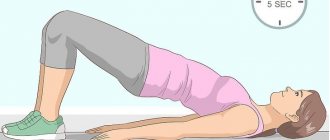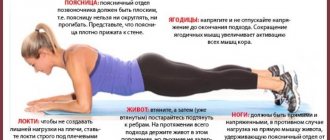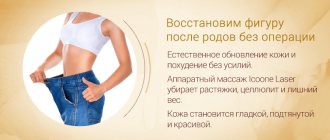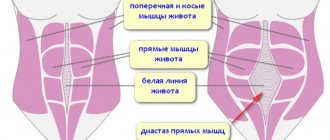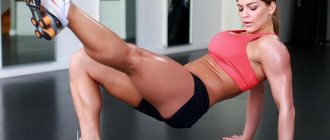Vacuum after cesarean section is the optimal physical activity on the abdominal muscles, which can be given to the body no earlier than 3 months after childbirth. To safely perform exercises, you must obtain permission from a gynecologist, make sure there are no contraindications, and strictly follow the algorithm.
The first results can be assessed no earlier than after 6 months, visible changes will be seen after 12 months - the stomach will no longer be saggy and protruding, at the same time the back muscles will become stronger, and the overall body weight will decrease.
The duration of the exercise is a maximum of 20 seconds; for beginners, this period should not exceed 7-10 seconds.
How does a vacuum work after a caesarean section?
Vacuum after cesarean section is an exercise that is specifically designed to eliminate a sagging, protruding abdomen. In principle, it is suitable for any weight loss, even if there is no history of caesarean section.
Its versatility is ensured by the principle of influencing the body in general and specifically the abdominal muscles:
- during inhalation, the abdominal muscles tense as much as possible;
- they remain in this tension for several seconds;
- During exhalation, the muscles do not relax, but are held by force in a tense, constrained state.
The result of such forceful action will be increased blood circulation specifically in the abdominal area, maximum saturation of tissue cells with oxygen. This ensures faster metabolism at the cellular level. The more muscles work, the faster they strengthen and tighten.
We recommend reading the article on how to remove belly fat after a caesarean section. From it you will learn about the causes of a large belly after surgery, how long it takes to recover, how to remove belly fat at home, and also with the help of surgery. And here is more information about how long after a cesarean section you can play sports.
pros
Before making a vacuum, every girl should understand what results she can safely expect after childbirth:
- Very simple. It doesn't require you to sweat a lot, so you won't feel tired or have trouble breathing.
- When you have it done, the internal organs do not move around the internal cavity, so there is no threat of uterine prolapse, vaginal prolapse or hernia.
- Constant practice will help reduce the volume of your stomach, which means you will want to eat less. You will lose weight without any effort.
- During such actions, the elasticity of the skin increases. This means that stretch marks will become almost invisible, and the figure itself will become less flabby. And also, thanks to active blood circulation, cells will begin to recover faster, which will make the skin soft and smooth.
- The internal organs (especially the uterus and the ligaments that support it) will recover faster. Everything that has shifted during pregnancy will fall back into place.
- When you vacuum the abdomen, the pressure inside the cavity decreases. This means that there is an outflow of venous blood saturated with carbon dioxide and the risk of hemorrhoids and varicose veins is reduced.
- If you had tears during pregnancy, training will help relax the pelvic floor muscles, which helps the cracks heal faster.
- If you start exercising before you conceive, giving birth will be easier.
- Regular exercise will remove stress from the spine and help you relax. And if your posture improves, it will be easier for your internal organs, even your gait will become more beautiful and easier.
Read also: How to remove a flabby, sagging or distended belly after childbirth
What exactly does such a warm-up do, and what is it aimed at strengthening:
- Transverse muscles that support internal organs.
- Reducing visceral fat, which accumulates around internal organs and is the most dangerous for the body.
- Improving gastric motility.
- Acceleration of metabolism.
As you can see, this technique cannot fail to have a positive effect on the body of a young mother after childbirth, which is why it is so loved by many.
The benefits and harms of abdominal vacuum after cesarean section
The benefits of vacuum exercises for the abdomen after cesarean section are as follows:
- the abdominal muscles are strengthened, due to which it tightens and does not bulge;
- the appearance of the skin improves - it becomes firmer, its elasticity is restored, and sagging disappears;
- intestinal function is normalized by stabilizing peristalsis;
- the ligaments that hold the internal organs of the abdominal cavity in an anatomically correct position are strengthened.
In addition, with regular training of the abdominal muscles, existing fat deposits are burned, and this ensures overall weight loss. If the exercise is performed in a sitting or standing position, then at the same time the back muscles will be strengthened - the usual pain in the lower back, in the area of the shoulder blades, will disappear.
If the exercise is performed strictly after the doctor’s permission, then it cannot cause any harm to health..
Laparoscopic or open surgery?
We perform open operations only in the presence of excess skin and its pronounced changes, when suturing of diastasis is performed together with abdominoplasty (removal of excess skin and “tightening” of the skin-fat flap). We usually work together with a plastic surgeon; in our opinion, such teamwork gives the optimal result.
The incision is made in the lower abdomen, in the bikini area. Through it, we dissect the skin-fat flap along the surface of the abdominal muscles - to the costal arches and sternum. We perform suturing of the anterior layers of the sheaths of the rectus abdominis muscles and plastic surgery of hernia(s), with or without the use of a mesh implant, after which we excise excess skin, often transfer the navel and close it with cosmetic intradermal sutures. Sometimes we supplement the operation with liposuction, but it must be taken into account that such a combination can lead to an increased risk of complications.
You can see our patient’s impressions after such an operation in her video blog (link to video review). She lives in the UK, but we operated on her in Moscow.
In other cases, we give preference to minimally invasive options for plastic surgery of diastasis of the rectus abdominis muscles. There are also several varieties of these operations:
Most colleagues perform laparoscopic plastic surgery, working from the abdominal cavity. Not the best option, in our opinion:
Appearance of the abdomen after laparoscopic (from the abdominal cavity) diastasis repair performed in a third-party clinic.
- When suturing the linea alba from the abdominal cavity, it is performed “from the inside out”. This inevitably results in the formation of a "keel" or "fin" of folded white line that protrudes outward. In thin patients this is visible with the naked eye, in others - if you look closely
- There is no dissection of the skin-fat flap. This leads to its deformation during suturing, and the navel becomes slit-like, which does not always suit patients.
- The location of the mesh implant in the abdominal cavity, which, as already discussed, can lead to specific complications
The cosmetic result of such an operation can be improved with the help of so-called “click” sutures, when we “collect” the excess white line when applying a suture. But the problem with deformation of the skin and navel remains with this technique.
We abandoned this technique and perform laparoscopic (or rather, endoscopic) plastic surgery of the anterior abdominal wall in a different way, working in the thickness of the layers of the anterior abdominal wall. This is certainly technically more difficult, the operation takes longer, but the result is worth it. With this method, I suture the linea alba “from the outside in,” hiding the excess linea alba into the thickness of the anterior abdominal wall. This is especially important in thin patients, in whom any deformation of the abdominal wall will be clearly visible.
Today, in most cases, we choose this technology for laparoscopic removal of diastasis and hernia - both with and without mesh.
Is it always possible to do a vacuum after a caesarean section?
It is strictly forbidden to make a vacuum after a caesarean section if:
- heavy menstruation, which is accompanied by pain in the lower abdomen;
- frequent dizziness;
- unstable blood pressure (hypertension or hypotension);
- infectious diseases occurring in acute or chronic form with frequent relapses;
- headaches of unknown origin;
- diseases of the kidneys and urinary system;
- diagnosed benign formations in the body of the uterus, including polyps and cysts;
- confirmed malignant tumors, regardless of their location in the body.
Conditional contraindications include: fever, acute respiratory viral diseases, exacerbation of chronic pathologies of the gastrointestinal tract. You can begin such physical activity only after your health has been restored.
What do doctors think?
Doctors do not deny that training with the “vacuum” exercise helps to tighten the stomach, and in the future, shape the abs, however, they pay attention to some contraindications, in which it is better to consult a doctor and not rush to work on your figure. You can do the exercise if there are no problems with the respiratory system, if the patient does not have diseases of the cardiovascular system or there are no chronic health problems. If you have the problems mentioned above, you must definitely visit your doctor, undergo the necessary examination and, based on its results, make a conclusion about the permissibility of the vacuum.
Despite the fact that the exercise is simple, it only takes a few seconds to perform a stomach vacuum, it has a significant effect on the entire body. Neglecting doctor's instructions can cause pain in the lower abdomen, hormonal imbalance, and disruptions in the menstrual cycle.
When to start: optimal time
Immediately after a cesarean section, any physical activity is contraindicated, so you should start performing the vacuum exercise to get rid of a bulging, sagging belly only taking into account the following doctor’s recommendations:
- If the operation was successful and the early rehabilitation period proceeded without complications, then physical activity on the abdominal muscles can be given only 3 months after childbirth. Begin classes in a daily mode of 3 approaches, each of which lasts 10 seconds maximum. It is better to limit yourself to 2 approaches so that there is no excessive tension on the muscle fibers and skin.
- In case of complications during the rehabilitation period after a cesarean section, such as inflammation with the formation of purulent exudate, cleaning the uterus from accumulated blood clots, or inflammation of the suture, any sports activities are postponed for at least 12 months.
Watch the video on how to make a vacuum:
In any case, childbirth by cesarean section makes it necessary to constantly monitor the woman’s health and the dynamics of suture healing by the doctor. It is he who will be able to determine the exact time to start classes, safe and effective in achieving the desired results.
How to properly apply a vacuum after childbirth
The vacuum exercise after childbirth is performed according to the following algorithm:
- Take a lying position, make yourself as comfortable as possible and relax all your muscles.
- Bend your legs at the knee joints, place your feet firmly on the floor - during the exercise, neither your toes nor your heels should be lifted off the surface.
- Extend your arms to the sides. You can rest your palms on the base of your thighs, almost on your pelvic bones.
- As a warm-up, take a few deep breaths and exhalations. You should not strain your abdominal muscles; you should remain in a relaxed state.
- Exhale as deeply as possible while simultaneously drawing in your stomach. In this case, its wall should “fail,” as it were, and the ribs should “diverge” a little.
- Hold your breath for 7-10 seconds for beginners and 20 seconds for experienced ones. You need to try not to let the ribs immediately “converge” and the stomach to return to its original position.
- After the specified time has passed, you need to inhale - slowly, measuredly. Gradually the abdominal muscles relax, the stomach returns to its normal state.
Vacuum lying on your back
In one approach, it is allowed to perform several such inhalations/exhalations with a breath hold for several seconds. In any case, a woman should focus on her own well-being - there should be no discomfort, abdominal pain, or shortness of breath.
You can perform the same exercise while sitting or standing, but only after strengthening your abdominal muscles. 4-6 months should pass from the start of training in a lying position.
On all fours Half-sitting, bent over, Sitting on a chair, Standing
Performance
In order for the effect to be maximum, any activity must be done correctly. Here in our case, a frequent question from young mothers about a vacuum for the abdomen about the technique of performing it after childbirth.
Read also Hoop after childbirth: benefits and harms: when and how best to start
You need to exercise on an empty stomach, without eating or drinking anything for 3-4 hours beforehand. For beginners, lying on your back is a good pose. This minimizes the pressure on the abdominal and pelvic floor muscles. You should lie on the hardest possible surface. Ideally, on the floor, but if this does not suit you, then choose a very hard mattress or sofa.
If you don't like to practice lying down, there is a "cat" position. You should kneel down with your palms on the floor. Once you get the hang of it, you can do this workout anytime, anywhere. For example, when sitting at the computer, standing or cooking.
It is also important to relax as much as possible and surrender to the sensations. If discomfort or pain begins, stop. If you feel a surge of strength, continue in the same spirit. In fact, the whole technique involves very deep breaths, when the abdominal part is drawn in as much as possible.
Here are detailed instructions to follow.
- Take a comfortable starting position and relax.
- To warm up, breathe a little, each time drawing in the air a little deeper, but not too much.
- Try to relax your abs as much as possible while inhaling.
- Smoothly draw in your stomach. The ribs should move in different directions.
- Now try to spread your ribs even wider and tighten your abs while holding your breath.
- Exhale slowly.
After how many seconds to release the air depends only on you. At first, you can hold the air inside for only a couple of seconds and do 3-5 approaches. Then gradually increase the load. If you can’t pull in very hard right away, don’t despair. All comes with experience. Regular practice will help you quickly become a guru. It will also be useful to try in front of a mirror, so you will see progress and know what to strive for.
Read also: Restoring your figure after childbirth while breastfeeding at home
What will be the result
You should not expect quick results after such training - the physical activity is not intense, the abdominal muscles are strengthened slowly even with full-fledged training in the gym. Therefore, the first assessments can be made only after 6-12 months from the start of classes.
What you can see:
- a toned stomach – the muscles will become stronger, the bulging will disappear;
- more elastic skin and less pronounced stretch marks;
- reduction in total body weight;
- elimination of pain in the back by strengthening its muscular frame;
- no constipation - intestinal motility works within normal limits.
Result before and after vacuum
If you add a diet to your exercises and perform other physical exercises, the process of losing weight will go much faster.
Consequences of early training and improper execution
The technique of performing a vacuum for the abdomen involves strong retraction of the abdomen, which leads to stretching of the incision, and this greatly increases the likelihood of the seam coming apart. Despite the fact that the abdomen is pulled “into itself,” the skin is still stretched.
If a woman does not take into account the doctor’s recommendations and prescriptions and starts doing exercises incorrectly or too early, then the following are possible:
- divergence of sutures - internal on the uterus and external on the skin;
- formation of a keloid scar on the seam due to its overstretching;
- development of the inflammatory process at the incision site;
- the formation of foci with purulent contents - if this occurs in the area of the internal suture, then additional surgical intervention will be performed.
We recommend reading the article about what exercises you can do after a cesarean section. From it you will learn how long after a CS you can start training, permitted and prohibited exercises, as well as contraindications to training. And here is more information about when you can pump up your abs after a caesarean section.
A vacuum for the abdomen after cesarean section, provided that the exercise is performed with the permission of a doctor, will be effective and safe. The lesson takes only a few seconds, and strengthening of the abdominal muscles and tightening of the skin will be noticeable within 6 months.
What could be the consequences?
In general, it is not recommended to immediately engage in any physical activity after a cesarean section, as it may affect the healing process of the incision. The vacuum technique involves maximum retraction of the abdomen, which means that the cesarean section incision can be stretched using a vacuum, which increases the risk of suture dehiscence. It is worth understanding that the skin is stretched, despite the fact that the exercise is done as if “into oneself”.
If a woman in labor decides to ignore all the doctor’s recommendations and prohibitions, she risks the following consequences:
- divergence of seams: internal and external;
- inflammation of the incision;
- formation of purulent foci. If it is easier to heal them on the external seam, then to treat the internal one, the external one will also have to be removed;
- stretching of the suture, which will lead to the formation of a keloid scar, much larger in area.
In addition, there are other contraindications that may force you to hold off on exercises to get rid of a sagging belly:
- heavy menstruation accompanied by pain;
- regular abdominal pain;
- various infectious diseases;
- migraines and dizziness;
- pathologies of the urinary system, as well as fibroids, polyps, cysts.
Useful video
Watch the video about using vacuum for diastasis:
Similar articles
- How to get rid of the belly after a cesarean section: home methods...
The main ways to get rid of the belly after a cesarean section, if it is large. How long does it take to recover, is it possible to lie on your stomach. How to get rid of and lose weight with a roller, wraps, vacuum. Popular abdominal surgeries after caesarean section. Read more - When can you pump up your abs after a cesarean section, after how long...
What to consider when choosing the timing of when you can pump up your abs after a caesarean section. After what period of time is it possible if there were complications. How to start training correctly. How to restore your stomach and abs after childbirth through cesarean. Read more
- How long after cesarean can you exercise...
How to know exactly how long after a cesarean section you can play sports. Why can't you start training right away? What can be included in the exercise program after cesarean and when: plank, aerobics, swimming pool, exercise equipment, running, squats, strength training, yoga, fitness. Read more
- Spinal anesthesia for caesarean section: how...
How spinal anesthesia is performed during caesarean section, complications and consequences after it for the woman and child. Which anesthesia is better for a CS - epidural, general. Contraindications to spinal anesthesia. How long does anesthesia last, how long does it take to wear off? How does a woman feel with him? Read more
- Exercises after cesarean section: when and how long after...
What exercises can you do after a cesarean section, and how long before you start training. What physical exercises can you do for the first time after weight loss surgery? What is suitable - jump rope, horizontal bar, gymnastics, exercise therapy, Kegel. Read more
